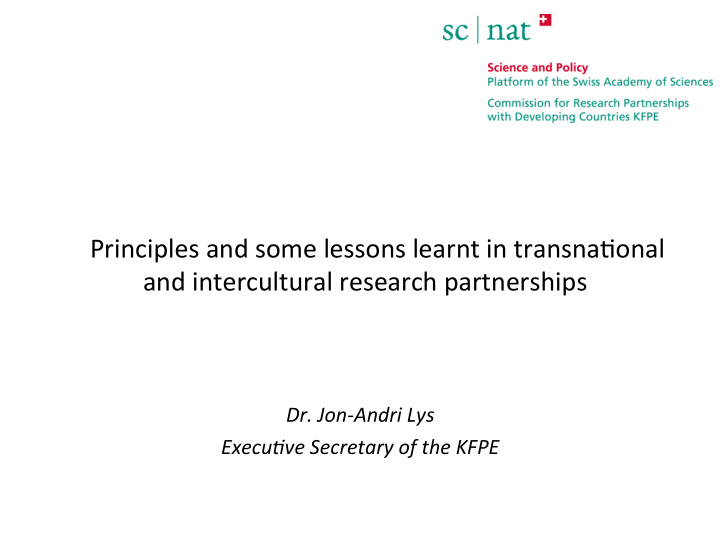



Principles and some lessons learnt in transna0onal and intercultural research partnerships Dr. Jon-Andri Lys Execu4ve Secretary of the KFPE
KFPE Swiss Commission for Research Partnerships with Developing Countries Mission: KFPE promotes efficient, effec0ve and equitable research co-operar0on with developing and transi0on countries. By doing so, it contributes to sustainable development and to solving global problems. Its members are experienced in the field of scien0fic research partnerships with developing and transi0on countries. At present, the associated ins0tu0ons include about 50 Swiss ins0tu0ons ac0ve in scien0fic research, in the promo0on of scien0fic research or in development, Departments of the Federal Government, and Founda0ons.
Main Ac0vi0es Suppor0ng Conceptual Work: Guidelines Impact Study Knowledge Awareness Rising Brokering Info PlaAorm Poli0cal level Bridging «North & South» Scien0fic & Development Development & Community Research
The Scien0fic Imbalance OECD Nics China 1995 2002 2007/8 India 2012/13 Brazil Rest 0 10 20 30 40 50 60 70 80 90 The distribu0on of worldwide spending for research (in %) (UNESCO Science Reports 1998, 2005 and 2010 & 2015)
Asymmetries / Power imbalances - Conceptual - Financial - Roles / Responsibili0es - Ownership of data/samples etc. Danger - > South serves only as a laboratory or as data provider Cartoon by Karl Herweg, CDE Univ. of Bern
A Guide for Trans-boundary Research Partnerships 11 PRINCIPLES 7 QUESTIONS The Guide ISSUES STUMBLING BLOCKS MAIN CHALLENGES TYPE OF PARTNERSHIP STEPS TO APPLICATION RATING PRINCIPLES
2012 principles (1) Set agenda together (2) Integrate with stakeholders (3) Clarify responsibili0es (4) Account to beneficiaries (5) Promote mutual learning (6) Enhance capaci0es (7) Share data & networks (8) Disseminate results (9) Pool profit & merits (10) Apply results (11) Secure outcomes
The 7 Key Ques0ons (stumbling blocks, main debates) Why to work in partnership ? Added value, Win-Win, Necessity (global issues) How to ensure cohesion ? Dividing Forces and Counterbalance What form of collabora0on ? Project, Network, Programme, Alliances Which foci and priori0es ? Research – Impact – Capacity Building Who to involve ? Peers, Beneficiaries, Donors, Intermediaries Where to create relevance ? 3 Types of Knowledge, Social Embedment When to consolidate outcomes ? Transdisc. Interact., Ins0t. Consolida0on
Research partnerships What is par0cular? RESEARCH CAPACITY IMPACT (-> Q-4: Which foci and priori0es?)
The tree basic goals are in conflict (Wiesmann, Stöckli & Lys, 2012)
Recommenda0ons to deal with these conflic0ng goals (Ques0on 4): 1) Clear priori0za0on in one or two of the goals. Adequate for projects limited in 0me and scope 2) Maintain all three goals but phase and/or subdivide the endeavour into specific components. Adequate for long-term programmes and networks/alliances
NCCR North-South A 12 year program, 2001-2013 9 Regions, more than 40 countries 197 regional partners Around 400 researchers involved Financed by SNSF and SDC hUp://www.north-south.unibe.ch
Joint Agenda seYng process (P1 & P3) Karl Herweg, CDE Joint undertakings stand a beFer chance when they benefit both sides (Euripides)
Capacity Building (P6 & Q7) An investment in knowledge always pays the best interest (Benjamin Franklin)
Interact & exchange with stakeholders (P2, P4, P8, P10 & Q5, Q6, Q7 ) We have two ears and one mouth so that we can listen twice as much as we speak (Epictetus)
Itera0on between disciplinary, interdisciplinary and trans-disciplinary approaches (Q-7) Institution Transdisciplinary from disciplinary to transdisciplinary dissemination and application Levels of collaboration: Programme Project Cumulative Project capacities Network (Multi-)disciplinary dissemination and application Duration of transboundary research partnerships
Conclusions For successful research partnerships, we need to understand: • our scien0fic and non-scien0fic partner’s mo0va0ons: –> the official narra0ve and the hidden, the different objec0ves • who wins in the partnership? … and who loses? … and who decides? etc • the expecta0ons from the applica0on side but also from the funding agencies • ways to make the partnership grow into an enduring rela0onship -> go for a balanced equilibrium Some addi0onal important ingredients: • Crea0ve listening • Respect and interest for the roots of the others (background, culture, history etc.) • Mutual learning (for change)
Thank you www.kfpe.ch
Recommend
More recommend